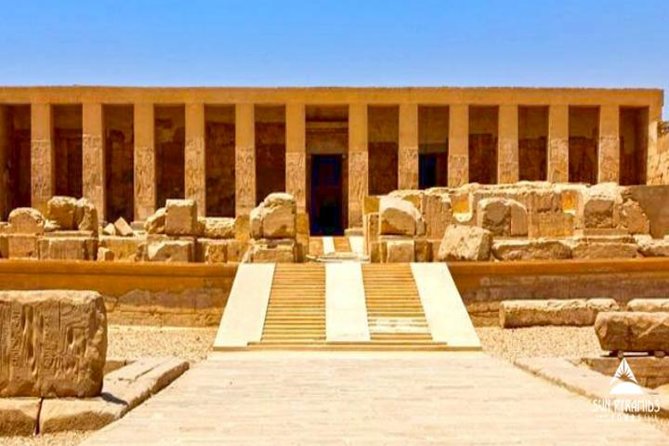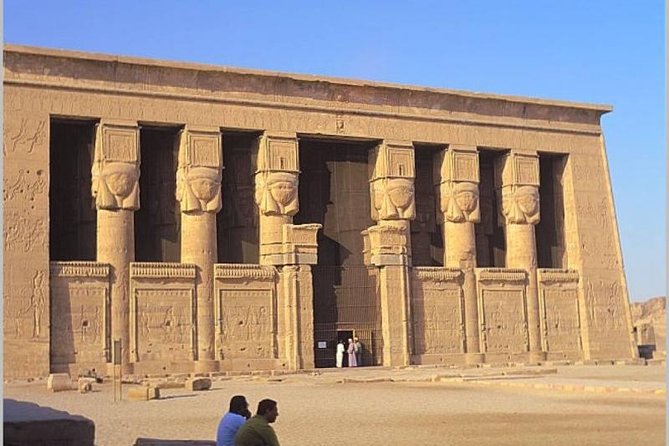Explore north of Luxor to see the well-preserved temples of Dendera Temple and Dendera Temple , known for their vivid colors. Abydos was a major pilgrimage center in ancient Egypt. It housed burials from the First and Second Dynasties, serving as a gate to the afterlife according to Egyptian beliefs. The Temple of Abydos, built by King Seti I of the 19th Dynasty, was completed by his son, Ramses II, after Seti’s death. This temple stands out with its breathtakingly decorated ceilings, showcasing the Egyptians’ attention to detail and admiration for perfection.
Dendera, a major capital of ancient Upper Egypt, was dedicated to the goddess Hathor, who was depicted as a cow. Hathor was later identified with the Greek goddess Aphrodite, associated with love and art. This connection makes sense because the temple was constructed during the Ptolemaic Dynasty, which had Greek origins.
In addition to their architectural and mummification skills, ancient Egyptians were also experts in astronomy. You’ll find stunning astronomical scenes and zodiac carvings on the ceilings of these temples. Visiting the exceptional temples of Dendera and Abydos is well worth the time and effort.
The mythologies of Abydos city
Abydos is a small town in southern Egypt, near Luxor. It is known for its local farmers, green fields, and ancient temples. This holy city was the center of Osiris worship. Egyptians named the god of the dead “Abydos” and believed that Osiris, who was murdered by his brother Seth, had his body cut into pieces and thrown into the river. The head landed in Abydos, making it a sacred burial site and cult center. To honor Osiris, the Egyptians built the Temple of Abydos.
Abydos Temple

The Temple of Abydos stands as one of Luxor’s top attractions. Its main features remain well-preserved, and the wall paintings still show their original colors. A notable highlight is the “Abydos List of Kings,” which records the names of royal rulers from Egypt’s monarchy. Also known as the Temple of Seti I, King Seti I built it in 1300 B.C., and his son Ramses II completed it.
Although the roof remains relatively intact, the pylon and forecourt have suffered significant damage. Nevertheless, partial reliefs depict Ramses II battling enemies in the Battle of Qadesh. Stairs lead to the upper court, where pillars display reliefs of Ramses II greeting the gods Osiris, Isis, and Horus. The outer hypostyle hall features reliefs of Seti I, which Ramses II completed after Seti’s death. In the inner hypostyle hall, made of sandstone and limestone, some parts remain unfinished, but the completed sections show Seti making offerings to Osiris and Horus.
Dendera Temple

Dendera city sits on the west bank of the Nile, south of Abydos. Most of Dendera’s monuments come from the Ptolemaic and late Coptic periods, with some relics from the New Kingdom. The Hathor Temple, also known as the Dendera Temple Complex, stands out as the most famous site. Built during the Greco-Roman period, this temple features ruins from the Old and New Kingdoms.
You will find two Roman wells and three parallel chapels in front of the temple entrance. Originally, the temple served as a healing center dedicated to Hathor—the goddess of fertility and healing, and the wife of Horus—and remains well preserved. The roof chapel dedicated to Osiris is particularly fascinating. The walls and columns showcase Roman emperors alongside Egyptian gods.
The Travel to Egypt company offers Nile River cruises and Luxor day tours that include visits to the Abydos and Dendera temples.












1 Comment